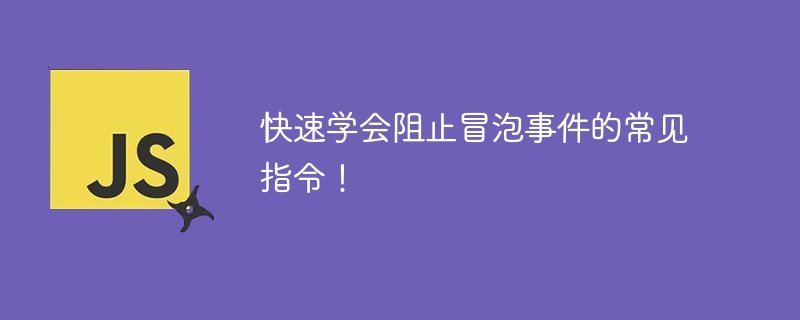Home >Web Front-end >JS Tutorial >Learn how to effectively deal with common bubbling incidents!
Learn how to effectively deal with common bubbling incidents!
- WBOYWBOYWBOYWBOYWBOYWBOYWBOYWBOYWBOYWBOYWBOYWBOYWBOriginal
- 2024-02-26 08:30:08930browse

Quickly learn common commands to prevent bubbling events!
With the development of web applications, the use of JavaScript is becoming more and more widespread. During the development process, we often encounter problems with bubbling events. A bubbling event means that when an event occurs on an element in the DOM structure, it will propagate upward to the parent element until it propagates to the document object. Sometimes, this bubbling event affects the normal functioning of our application. In order to solve this problem, we need to learn some common instructions to prevent the propagation of bubbling events.
- event.stopPropagation()
This is the most common instruction to stop bubbling events. When an event is triggered, calling the event.stopPropagation() function in the event handler can prevent the event from continuing to propagate to the parent element. For example, we can use this directive in a button's click event handler to avoid triggering the parent element's click event when the button is clicked.
document.getElementById('button').addEventListener('click', function(event) {
// do something
event.stopPropagation();
});- event.stopImmediatePropagation()
Sometimes, multiple event handlers of the same type are bound to an element, and we just want to prevent the propagation of the current event instead of Prevents the execution of other handlers for events of this type. At this time, we can use the event.stopImmediatePropagation() function. This function will not only prevent the propagation of the event, but also prevent the execution of subsequent event handlers on the same element.
document.getElementById('element').addEventListener('click', function(event) {
// do something
event.stopImmediatePropagation();
});
document.getElementById('element').addEventListener('click', function(event) {
// do something else
});In the above example, the event.stopImmediatePropagation() function in the first event handler will prevent the execution of the second event handler.
- event.cancelBubble
In addition to using functions to prevent event propagation, we can also directly set the cancelBubble property of the event object to true to achieve the same effect.
document.getElementById('element').addEventListener('click', function(event) {
// do something
event.cancelBubble = true;
});It should be noted that the event.cancelBubble attribute is only supported in IE browser and not in other browsers.
- return false
Using the return false statement in the event handler can also prevent the propagation of events. The effect of returning false is equivalent to calling the event.stopPropagation() and event.preventDefault() functions at the same time.
document.getElementById('element').addEventListener('click', function(event) {
// do something
return false;
});It should be noted that using the return false statement is only applicable to the case of using a framework such as jQuery to bind the event handler, and is not applicable to the case of directly using addEventListener to bind the event handler.
The above are the common instructions to quickly learn to prevent bubbling events. By using these instructions appropriately, we can better handle bubbling events during the development process and improve application performance and user experience. By strengthening the learning and understanding of these instructions, I believe you will be more comfortable in development and quickly solve problems related to bubbling events.
The above is the detailed content of Learn how to effectively deal with common bubbling incidents!. For more information, please follow other related articles on the PHP Chinese website!
Related articles
See more- How to find the IE browser that comes with win7 system
- How to implement click event in layui
- What should I do if jquery is not compatible with lower versions of IE browsers?
- An article to quickly learn css through animation!
- How to use JavaScript bubbling events to achieve multi-level interaction: build complex interactive experiences

